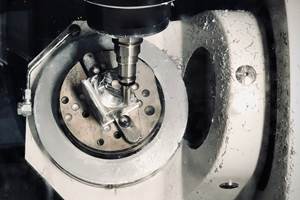Video: Form Tools On CNC Lathes
Form tools are traditionally associated with non-CNC machines, but in certain applications they make sense on modern machines as well.
Share





Őż
On a CNC lathe or turning center, one way to machine a complex cylindrical profile is obvious. That is: program a single-point turning insert to feed along the geometry of that profile. It might seem that there is no other way.
However, there is also a method for machining these profiles that preceded the development of CNC. And in certain applications‚ÄĒeven on CNC machines‚ÄĒthis is still the more efficient approach. That method involves form tools.
Indeed, according to form tool maker Schwanog, CNC machining processes now account for the majority of the company’s sales for this type of tooling.
Form tools are custom inserts. The cutting edge matches the intended profile of the part. As a result, a single straight plunge with the insert produces the desired shape. This has long provided a way for non-CNC production equipment such as automatic screw machines to achieve complex turned profiles, so it might seem counter-intuitive to forgo programmability in order to use the same kind of custom tooling on a CNC machine. Yet Schwanog U.S. general manager Holger Johannsen says there are important advantages of form tools that, in the right applications, make them more cost-effective than standard turning inserts on CNC equipment.
The most significant of these advantages is time. The video above illustrates this. When the same turned profile is machined with a form tool against a series of single-point cutters, the simple in-out stroke of the form tool allows the profile to be machined in about one-third of the time. Given a large enough volume, this time savings can become attractive enough to justify the investment in the custom tool.
But perhaps surprisingly, accuracy also figures into the use of this tooling. The reason relates to reduced variables. A standard turning tool following an interpolated path involves two machine axes where a form tool uses only one machine axis. With fewer moving elements to contribute to process error, the form tool can often make it easier to consistently achieve tight precision.
Mr. Johannsen says one further advantage is finish. With a single-point tool, inevitably there are cusps between rotations of the workpiece as the cutting edge travels along the contour. A form tool omits these cusps, because the entire segment of the part represented by the form is machined in a single plunge.
Every form tool is a special order. Each is engineered to geometry provided by the end user. This obviously means there is significant additional cost involved in specifying the form tool instead of a standard tool. The applications that can benefit from one or more of the advantages above‚ÄĒcycle time, accuracy or finish‚ÄĒare the ones that can justify the expense.
Still, a direct price comparison between standard and custom tooling does not necessarily account accurately for the cost difference, Mr. Johannsen says. One additional factor is tool life. When a single-point insert machines all the way along some profiled segment of the part, all of the energy of the cut contributing to tool wear is concentrated into that single narrow ‚Äúpoint‚ÄĚ of contact between the cutter and the part. By contrast, the form tool cuts along a line of contact, with the energy of the cut distributed along the profile. As a result, a form tool can be counted on to wear much more slowly‚ÄĒnot only reducing the rate at which new inserts need to be purchased, but also reducing the amount of time that is lost to tool replacement.
Related Content
Inside a CNC-Machined Gothic Monastery in Wyoming
An inside look into the Carmelite Monks of Wyoming, who are combining centuries-old Gothic architectural principles with modern CNC machining to build a monastery in the mountains of Wyoming.
Read MoreHow to Successfully Adopt Five-Axis Machining
While there are many changes to adopt when moving to five-axis, they all compliment the overall goal of better parts through less operations.
Read MoreHigh RPM Spindles: 5 Advantages for 5-axis CNC Machines
Explore five crucial ways equipping 5-axis CNC machines with Air Turbine Spindles® can achieve the speeds necessary to overcome manufacturing challenges.
Read MoreQuick-Change Tool Heads Reduce Setup on Swiss-Type Turning Centers
This new quick-change tooling system enables shops to get more production from their Swiss turning centers through reduced tool setup time and matches the performance of a solid tool.
Read MoreRead Next
Machine Shop MBA
Making Chips and łŖŇ‚¬ ŃýļŌ≤ are teaming up for a new podcast series called Machine Shop MBA—designed to help manufacturers measure their success against the industry’s best. Through the lens of the Top Shops benchmarking program, the series explores the KPIs that set high-performing shops apart, from machine utilization and first-pass yield to employee engagement and revenue per employee.
Read MoreAMRs Are Moving Into Manufacturing: 4 Considerations for Implementation
AMRs can provide a flexible, easy-to-use automation platform so long as manufacturers choose a suitable task and prepare their facilities.
Read More





















